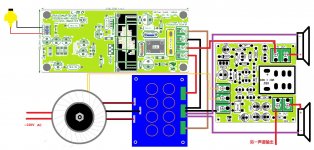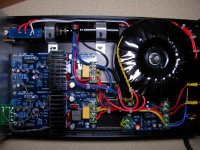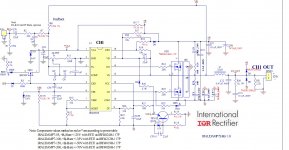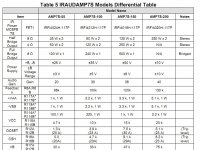Be careful what you do with the 12 volts to the 2092. It can be a bit touchy about decoupling close to the regulator and close to the 2092.
I didnt decouple mine well enough and I started getting clicking through the audio.
Turned out to be glitches on the VCC 12 volt rail.
Actually, I was just talking about how to modify a speaker protection board to use 12V DC vs 12VAC, not the L15D itself..
A friend asked me to help him make a connection diagram plus protection.
I paste to come over.
I suddenly feel the urge to buy it...
Is that a speaker protection circuit? How much does it all cost, shipping included, without potentiometer?
ljm_ljm, a 50k input pot on the L15D?
No problem
ljm_ljm, I know your L15D and L20D are based on the IR reference design, but looking at the boards, is it correct to conclude that you did not include the over/under voltage protection circuitry(page 31 of the Reference Design document) in your designs? I don't see it in the board layout.
Last edited:
The over/under voltage protection I'm talking about in the International Rectifier 2092 Reference design is for the power supply voltages, not the input voltage..
No power supply voltage forced close protection function.
But the power supply voltage and IRAUDMP7S principle is the same.
The power supply voltage not more than recommended. May be damaged.
Don't lower than the value of the request, will work is not stable.
Can you provide an exact schematic of your design please? I know you based your design on the Reference Design, the differences can be confusing. If users are attempting to replace the resistors to us a lower voltage supply, it is not straightforward to identify which are the correct components to replace.
Hi all,
I'm building a 7.2 active speaker system that will require about 20 channels of amplification. They will all be line arrays with some being 2 way and some 3 way. For the amplification, I am interested in purchasing 10 kits (20 modules) but wonder what else I need to consider. I would like to drive my speakers at 4ohm.
1. Could I use those boards and combine them into this type of multi-channel amp?
2. What will be the cheapest way for me to combine suitable power supply in order to power all channels. I rather not have one power supply for each two modules but maybe that is needed?
3. Would the above work or do I need to consider something else?
As you can hear I'm a novice to this but would love to build something myself.
Any advice is appreciated.
Regards,
Exipnos
I'm building a 7.2 active speaker system that will require about 20 channels of amplification. They will all be line arrays with some being 2 way and some 3 way. For the amplification, I am interested in purchasing 10 kits (20 modules) but wonder what else I need to consider. I would like to drive my speakers at 4ohm.
1. Could I use those boards and combine them into this type of multi-channel amp?
2. What will be the cheapest way for me to combine suitable power supply in order to power all channels. I rather not have one power supply for each two modules but maybe that is needed?
3. Would the above work or do I need to consider something else?
As you can hear I'm a novice to this but would love to build something myself.
Any advice is appreciated.
Regards,
Exipnos
Hi all,
I'm building a 7.2 active speaker system that will require about 20 channels of amplification. They will all be line arrays with some being 2 way and some 3 way. For the amplification, I am interested in purchasing 10 kits (20 modules) but wonder what else I need to consider. I would like to drive my speakers at 4ohm.
1. Could I use those boards and combine them into this type of multi-channel amp?
Sure, it's been done before.. I think these are great "modules" for multi-channel systems, since they are very small, for the power they are capable of.
2. What will be the cheapest way for me to combine suitable power supply in order to power all channels. I rather not have one power supply for each two modules but maybe that is needed?
Probably something like a SMPS supply from Connexelectronic. Cristi has a number of Power supplies with different ratings, 300 - 1000W, so you could run up to 4 channels per 1000W supply.
3. Would the above work or do I need to consider something else?
No, probably just casing, and layout, and if you want an all in one chassis, or split them up some way or the other..
As you can hear I'm a novice to this but would love to build something myself.
Any advice is appreciated.
Regards,
Exipnos
Last edited:
Can you provide an exact schematic of your design please? I know you based your design on the Reference Design, the differences can be confusing. If users are attempting to replace the resistors to us a lower voltage supply, it is not straightforward to identify which are the correct components to replace.
And the reference design is The same.
The reference.
Attachments
L15D or L15D X2?
What is the difference between these? How does the sound compare between one stereo board and two mono boards?
IRS2092 IRAUDAMP7S high end class D stereo Amplifier | eBay
eBay - New & used electronics, cars, apparel, collectibles, sporting goods & more at low prices
What is the difference between these? How does the sound compare between one stereo board and two mono boards?
IRS2092 IRAUDAMP7S high end class D stereo Amplifier | eBay
eBay - New & used electronics, cars, apparel, collectibles, sporting goods & more at low prices
Probably something like a SMPS supply from Connexelectronic. Cristi has a number of Power supplies with different ratings, 300 - 1000W, so you could run up to 4 channels per 1000W supply.
Or more channels, depending on power requirement and where the amps are located.
What is the difference between these?
Something to keep in mind is that the heat sink fins of the stereo board be vertical, unless you use a fan, requiring a much taller case than the mono boards.
If that's OK, then you can fit more amp channels in a given volume.
Last edited:
What is the difference between these? How does the sound compare between one stereo board and two mono boards?
IRS2092 IRAUDAMP7S high end class D stereo Amplifier | eBay
eBay - New & used electronics, cars, apparel, collectibles, sporting goods & more at low prices
I'm interested in purchasing the L15D or L20D from one of these sellers but wanted to contact along1986090 before hand but could not find any contact info. ljm_ljm or anybody else have their details?
Something to keep in mind is that the heat sink fins of the stereo board be vertical, unless you use a fan, requiring a much taller case than the mono boards.
If that's OK, then you can fit more amp channels in a given volume.
Does anyone know how tall this heatsink is (the stereo board)? I didn't factor that in. I have a 4" tall case.
- Home
- Vendor's Bazaar
- LJM Audio



